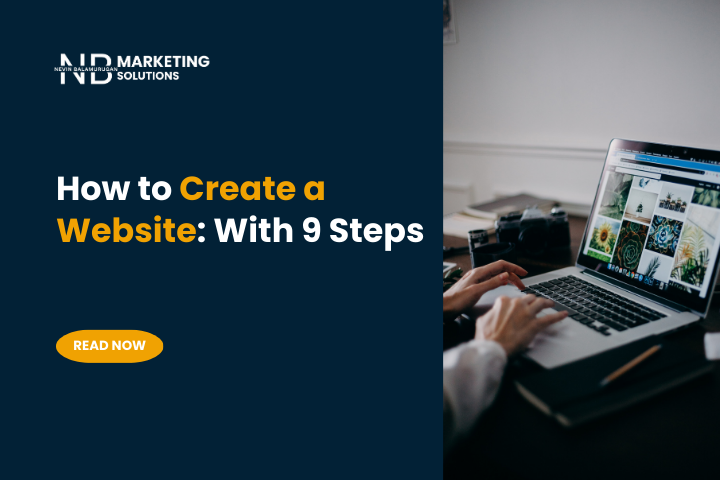How To Create a Website From Scratch in 9 Steps
Abirami Dharmalingam
August 21, 2025

Create a Website From Scratch in 9 Steps (No Coding Required)
You’ve built your business – now you’re ready to create a website from scratch.
Today, customers expect to connect with businesses at any time, so a business website is the ideal platform for that. It’s where customers can learn about what you do, contact you, and even make a purchase.
Creating a website has gotten easier over the years. Now, it’s cheaper, faster, and more straightforward than ever before.
But what do you need to build a website?
Have no idea. No worries, we’re here to guide you.
In this blog, we’ll teach you how to create a website for your business with a step-by-step process.

Here is the Easiest Way to Create a Website With a Website Builder
Here is the step-by-step process to create a website for your business using a website builder.
- Decide on the purpose of your website
- Choose a website builder
- Pick a domain name
- Pick a premade website template
- Decide on a layout
- Add relevant pages
- Write optimized content
- Implement search engine optimization (SEO)
- Track your website metrics
Step-By-Step Guide to Create a Website For Your Business
Before creating your website, choose the website builderthat suits you. You may have a question about the website builder. So, let us give you a definition of it.
A website builder is a tool that enables you to create and design websites without coding. It offers domain names, SSL certificates, and templates in one package, typically for a monthly or yearly subscription fee.
Here are some examples of website builder platforms you can use to create a website.
- Squarespace
- Wix
- Shopify
- Carrd
- Webflow
- HubSpot
- WordPress.com
- Weebly
- Hostinger
- GoDaddy
So, a website builder is the easiest way to create a website, especially for beginners. Each of the website builder have different features and subscription plans. If you need to go into detail, the 10 best free website builders might help you.
Now, follow the steps below to create a website from scratch using a website builder.
1) Decide on the purpose of your website
Before creating your website, the first step is to set your goals.
What do you want to achieve by creating a website?
- Selling products
- Selling services
- For portfolio
- For growing your audience
- Sharing updates or announcements about your brand
Developing a vision for your site will help you choose which features to work. Once you identify your purpose, you can prioritize the right features and structure – make a plan to achieve it.
2) Choose a website builder
Next, choose a website builder that suits your goals and budget. Here’s what you need to consider:
- Cost: Many website builders require a subscription for premium features like custom domain names, extra storage, or e-commerce tools.
- Features: Website builders offer various features depending on their target market. For example, Shopify is designed for e-commerce, while WordPress.com is perfect for blogging. So, think about your goal and what features you need.
- Extensions and Add-ons: Check out the builder’s add-on library you’re considering. If they offer something you need – choose it, if not – skip it.
- Design Templates and Themes: Some platforms offer a variety of themes and templates. Check out the template library to see if they suit your brand style.
Always start with a free trial or free plan. Creating a dummy website lets you explore the website builder’s tools and design capabilities without any commitment.
Here, we recommend some paid subscriptions to create a website once you have decided on your goals.
| WEBSITE BUILDER | BEST FOR | PLAN |
| Squarespace | Creative websites | $16 to $52/month |
| Wix | General websites | $17 to $159/month |
| Shopify | E-commerce | $29 to $2,300/month |
| Carrd | One-page website | Free to $49/year |
| WordPress.com | Blogs | $4 to $45/month |
| Hubspot | General websites | Free to $1,500/month |
3) Pick a domain name
Your domain name is your online identity, so it’s important to choose it carefully. Aim for a name that’s short, easy to remember, and clearly reflects your business or what you offer. Including relevant keywords can also help improve your visibility on search engines.
When searching for a domain, check its availability across popular domains like .com, .net, and .org. You can also explore newer options such as .io or .co to get creative – just make sure the extension suits your brand and industry.
Avoid using hyphens, numbers, or complicated spellings that can confuse customers. If your preferred .com domain is already taken, consider adding your location or a descriptive keyword to find an alternative. Before finalizing, do a quick search to ensure the name isn’t trademarked or already in use by someone else.
4) Pick a premade website template
The next step is to select a template (or theme) to create a website. This is the starting point of your website’s design and structure – a ready-made layout to start. Most website builders recommend templates based on your niche – so you’ll find designs for:
- Local businesses
- Creative portfolios
- Freelancers
- Bloggers
- E-commerce
- Non-profit or community pages
A good template should have essential features like a drag-and-drop editor (to customize easily without coding) and built-in responsive settings. Many platforms also offer demo content, so you can replace images and text instead of creating a website from scratch with coding.
5) Design on a layout
While templates give you a great start, the challenge is that many others might be using the same one. That’s why customization is key – your layout should reflect your brand and stand out.
Most website builders allow you to personalize your design by:
- Changing the color palette to match your branding.
- Replace stock images with your photos or graphics.
- Adding social media icons for easy connection.
- Customizing forms, menus, and navigation to fit your site’s purpose.
- Adjusting button size, shape, and font styles to create a consistent look.
6) Add relevant pages
Next, it’s time to add pages to your site. These pages provide structure, improve navigation, and ensure your customers can easily find the information they need. You’ll need to create,
- A home page
- An about page
- A contact us page
- A services page (if you’re offering any)
- A product page (if you’re selling any)
- A blog page (if needed)
If you are offering services, create a specific service page and break it down into more specific subpages. For example, instead of one generic “Digital Marketing Services” page, you could create individual sections such as “Social Media Marketing Services” and “Search Engine Marketing Services” under the digital marketing services umbrella.

7) Write optimized content
Lastly, compress images before uploading with a tool. These steps will ensure your content helps you rank on Google and other search engines.
Aim for at least 300 to 600 words per page to provide quality content and add whitespace too. Write your content in an editor like Word or Google Docs, and use tools such as Grammarly to ensure your content is error-free.
Moreover, you need to adjust:
- Page titles
- Headings (Main and Sub-heading)
- Meta descriptions
- Image alt-text
- Page URLs
- Structured markup
8) Implement search engine optimization (SEO)
For small businesses, ranking in search not only helps customers find you, but it can also increase your credibility with them. You can find some SEO tips for small businesses here:
- Pick a short and memorable domain name.
- Do some keyword research – what search terms do you want your website to appear in from search results? How competitive will it be to rank for those searches? You can find a lot of useful information directly on search results pages, or explore free keyword tools.
- Create descriptive URLs related to your page content, which will help you with link-building and social sharing.
- Create a custom title tag for every single page and post, and include one keyword that is relevant to the content on the page in your title tag.
- Write meta descriptions with short pieces of text that summarize the content of your page, that are compelling, and include relevant keywords and important terms like brand names.
9) Track your website metrics
You need to track the success of your products and services, and you’ll want to use an analytics tool to check on the health of your website.
How much traffic is your website driving?
How much of it is coming from search?
What are your most popular and least popular pages?
Use Google Analytics and Google Search Console to help you answer these questions as you look to grow your web presence.
Create a Website With Website Builder Now
Creating a website is easy today. You have a number of website builders to create a website for your business.
We’ve covered all the necessary details for building your first website. If you find yourself getting stuck anywhere, you can turn to NB Marketing Solutions to solve your problem. We handle your queries.
Choosing a website builder, designing your website, and marketing can be risky. You can’t expect overnight success, but with a bit of patience, you’ll see real progress.
Trust us, creating a website for your business can bring new customers to your product or service.
Recent Posts
Have Any Question?
- (+91) 938-542-1049
- info@nbmarketingsolutions.in
Categories
Make Appointment
Confused Over Choosing The Right Services For Your Business?
Tamil Nadu, India
- Near TMB Bank, Anjugramam post, Kanyakumari 629401
- info@nbmarketingsolutions.in
- (+91)93-8542-1049
